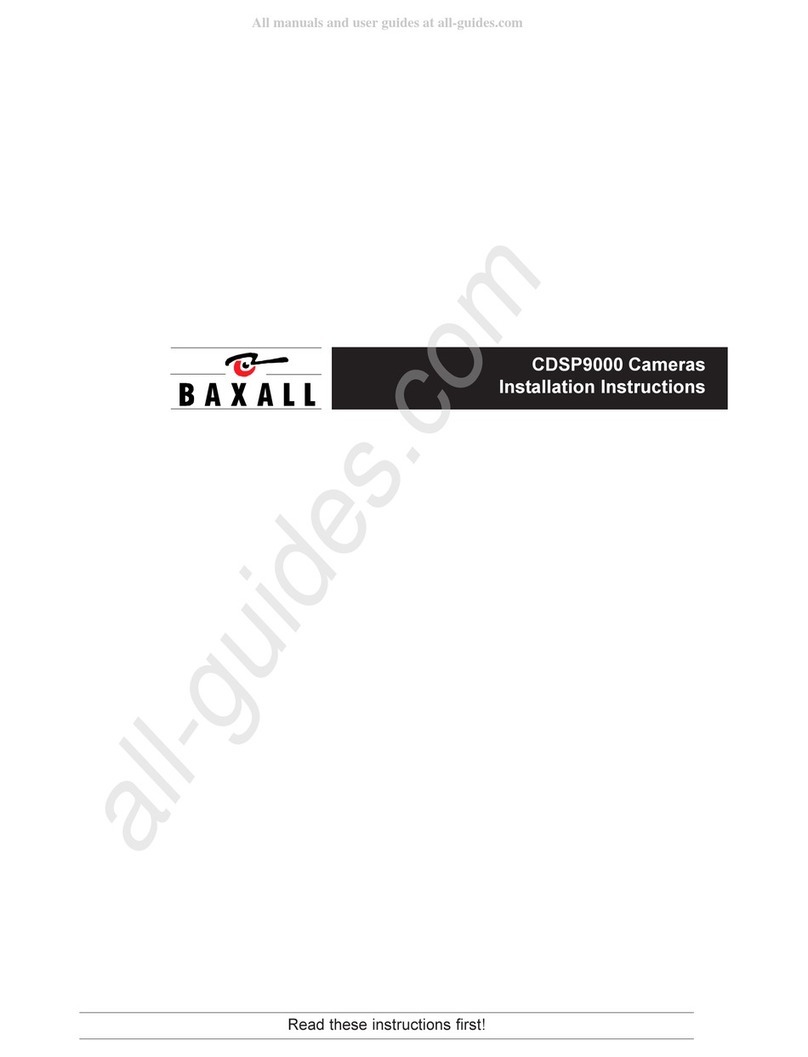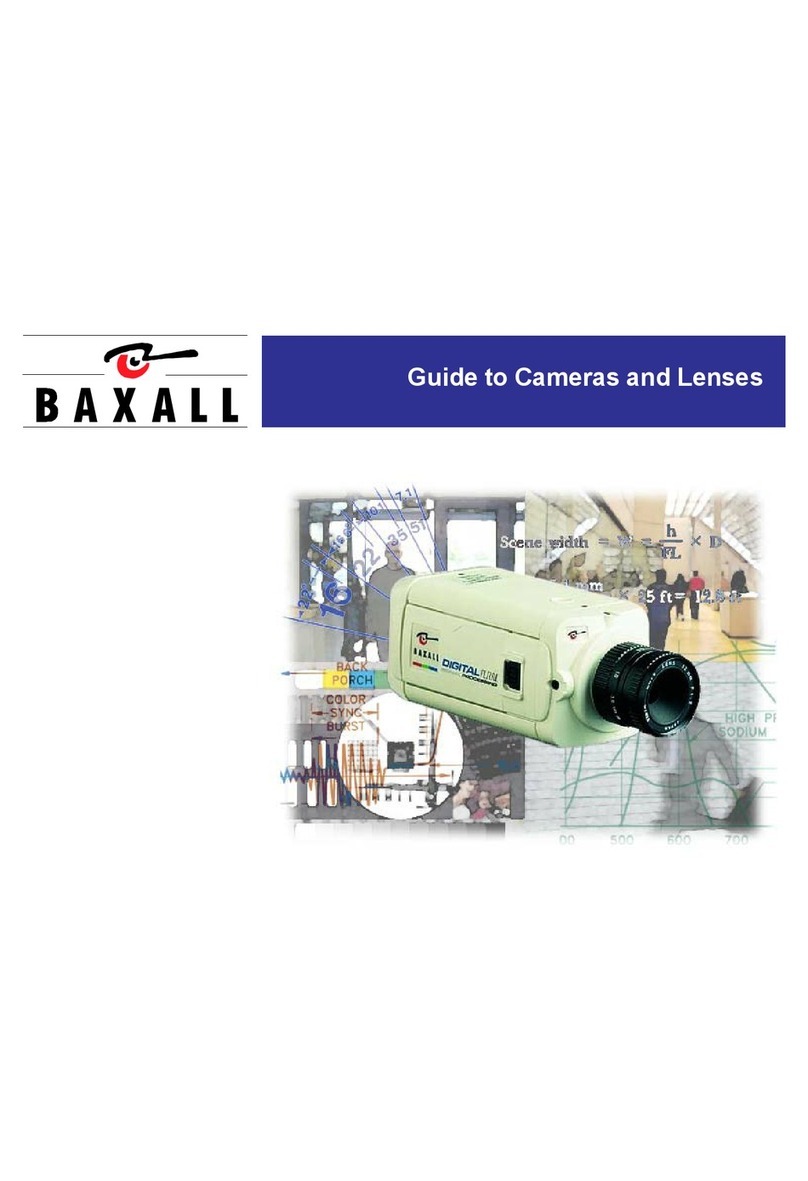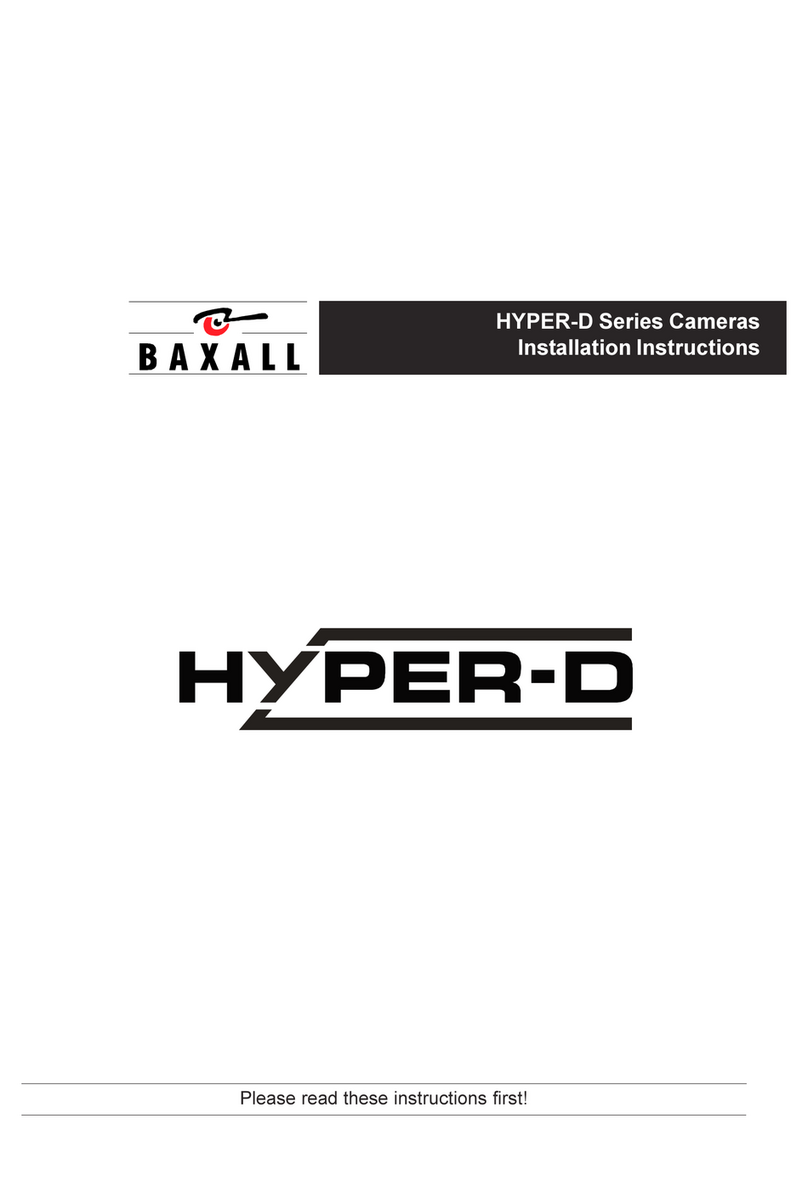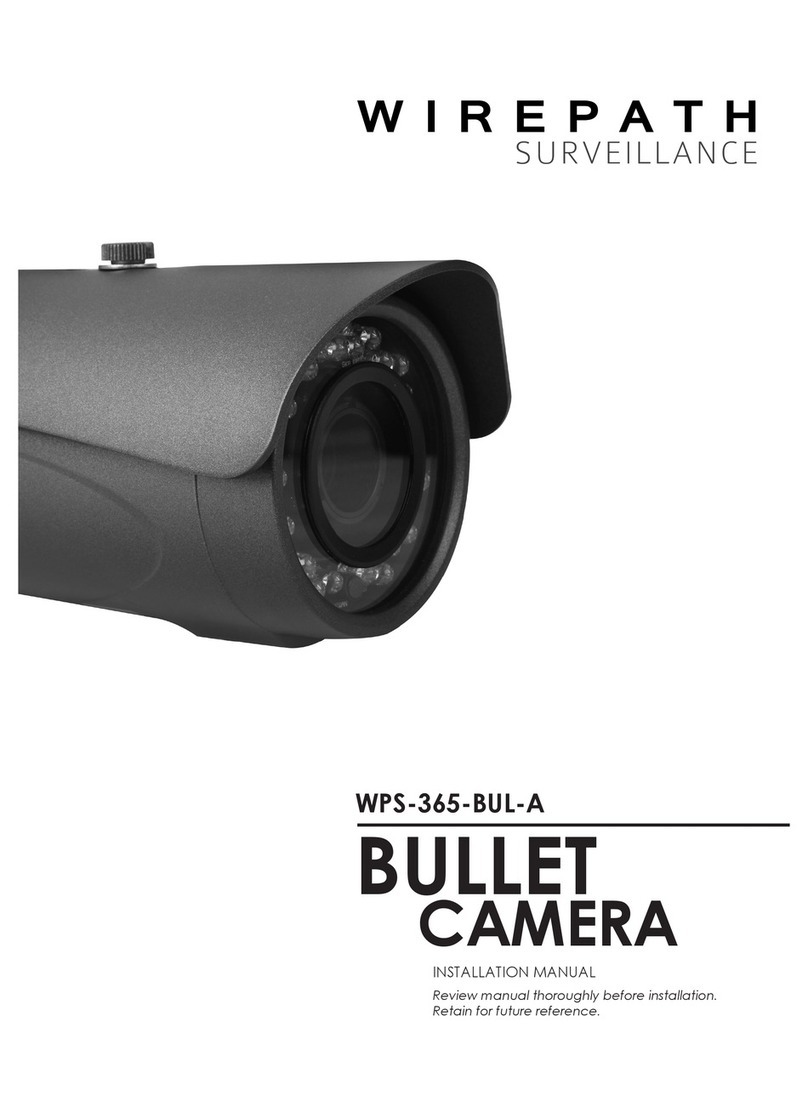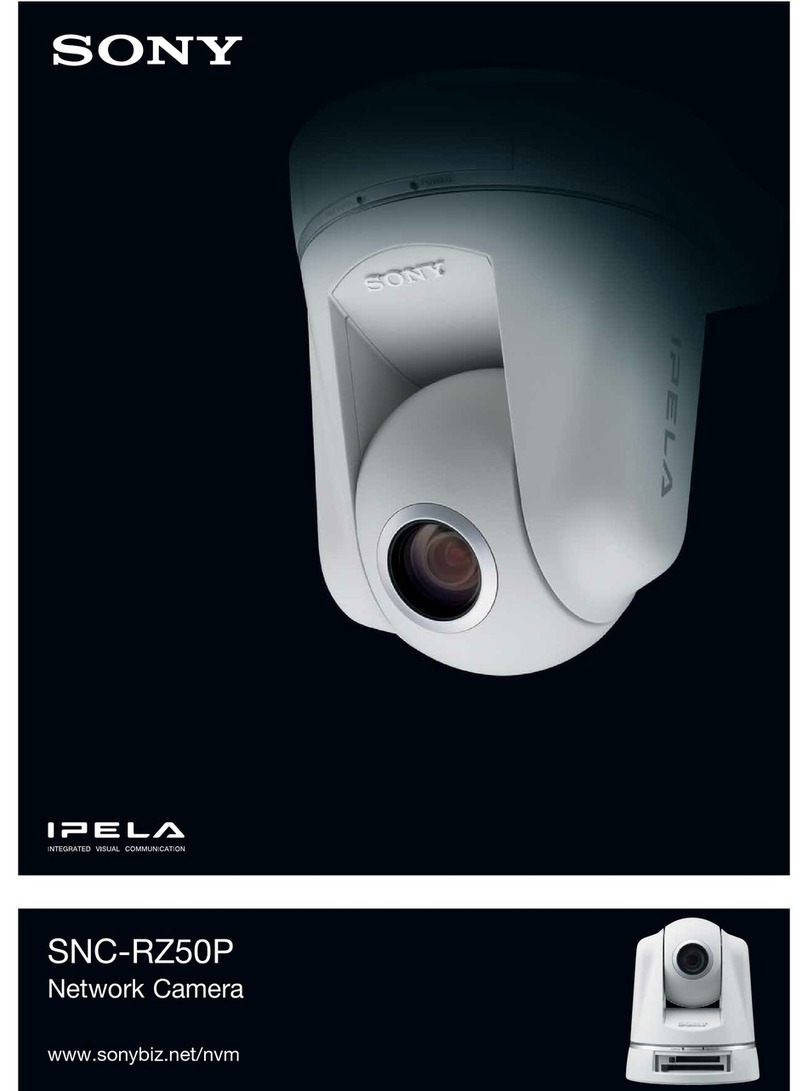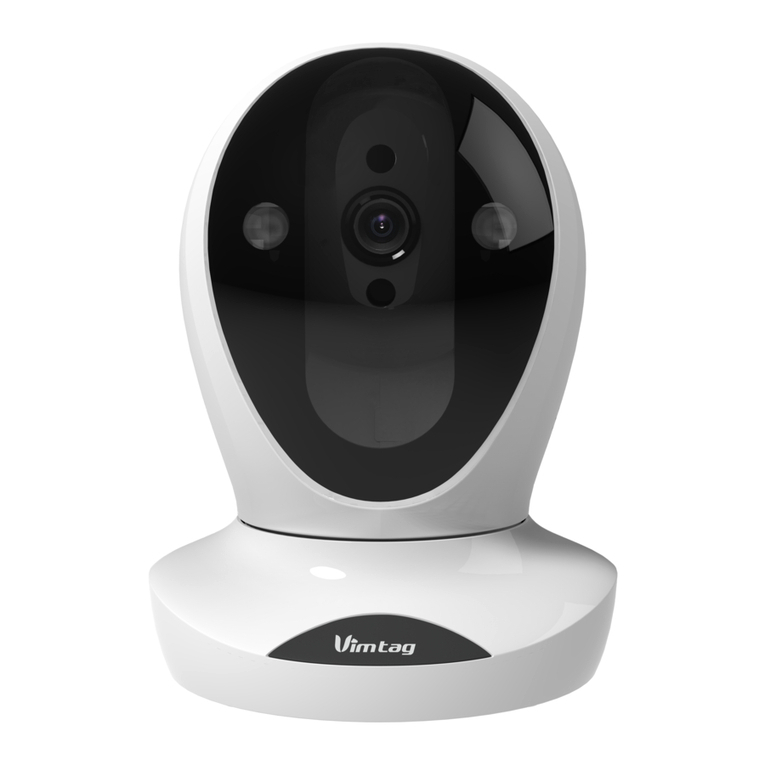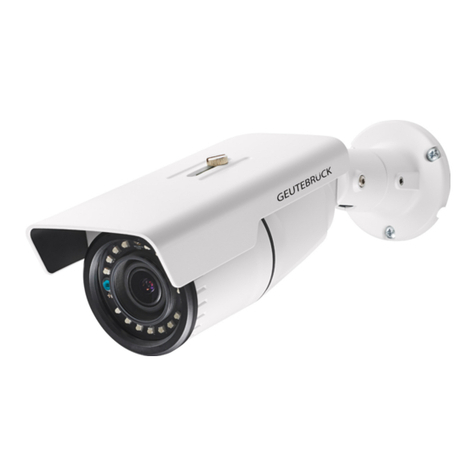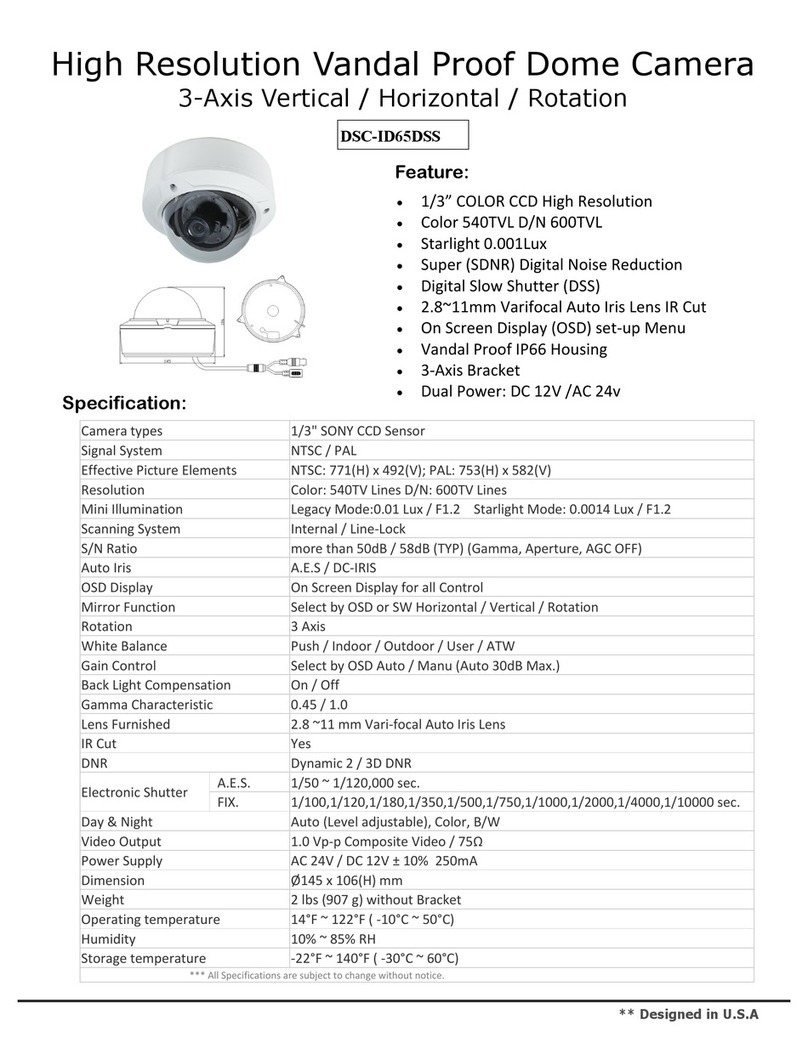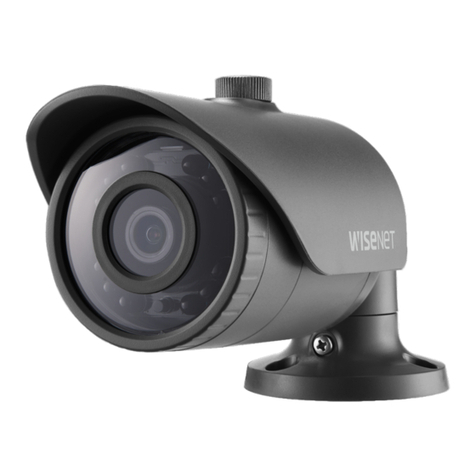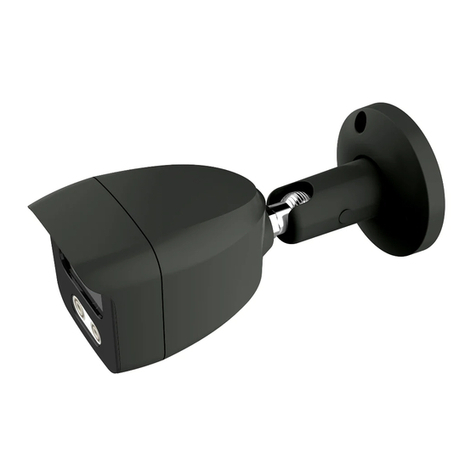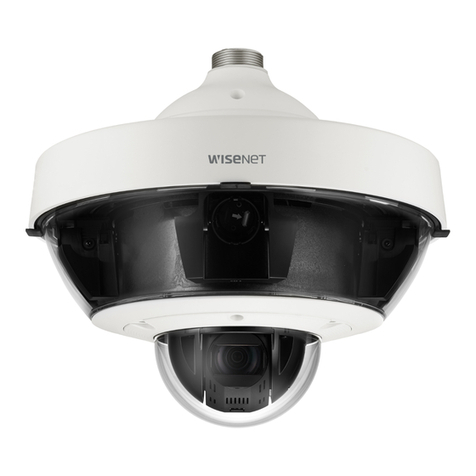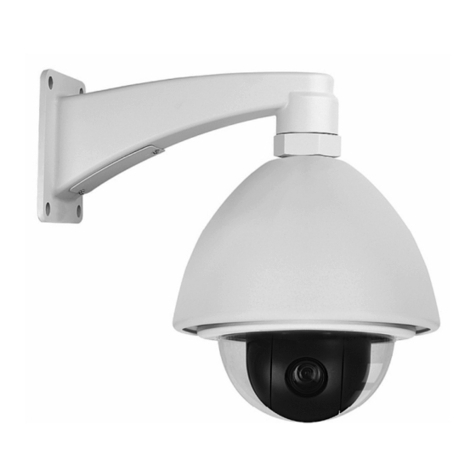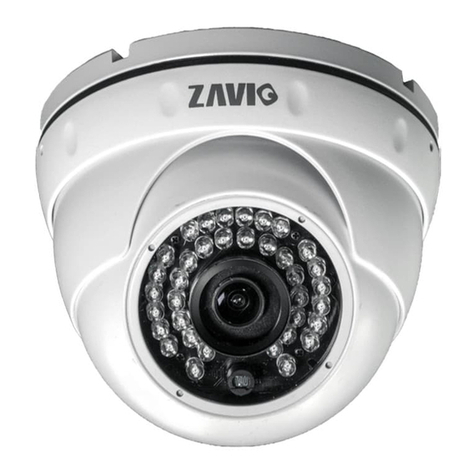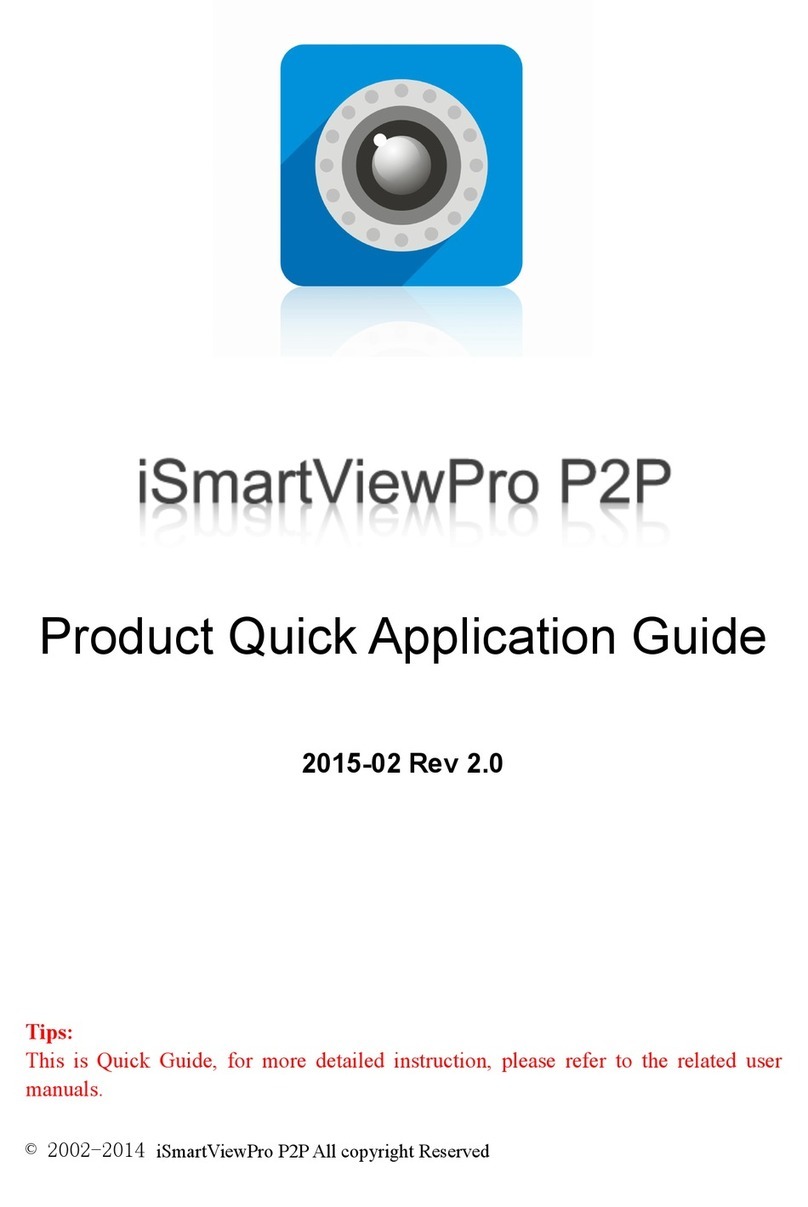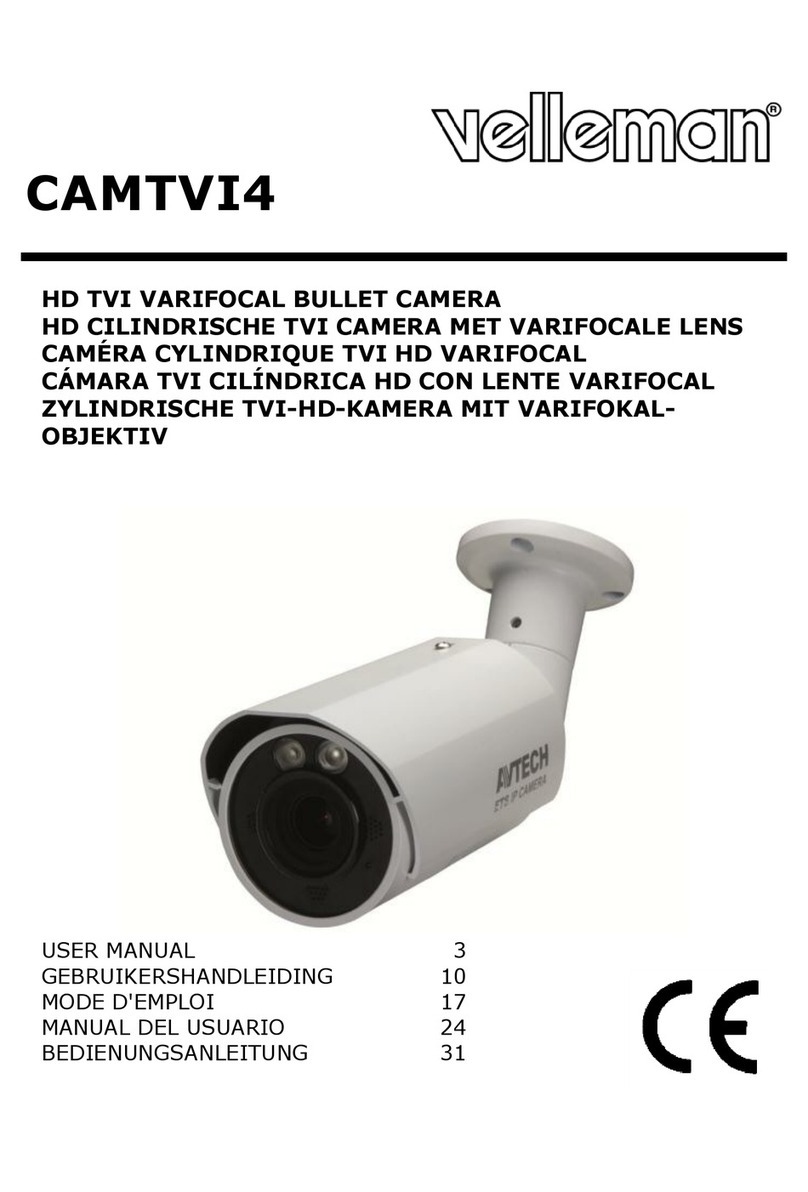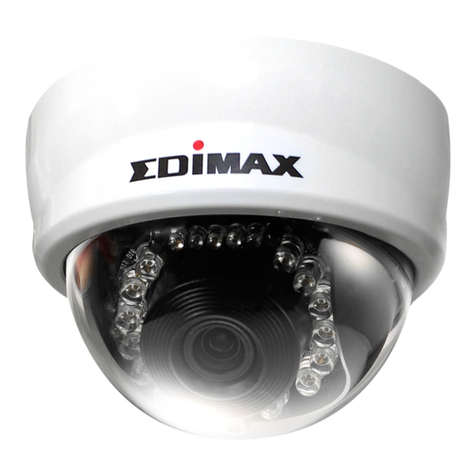Baxall CDSP9000 SERIES User manual

CDSP9000 Cameras
Installation Instructions
Read these instructions first!

Page 2
CDSP9000 Cameras Installation Instructions
INTRODUCTION
These instructions cover Baxall CDSP9000 series cameras. Read all of these instructions.
se them to install your camera and have them available for its lifetime. If you have any
problems, contact Baxall Limited. Note that not all cameras have all of the features described
in this manual. Refer to the table below for the features of individual cameras. All CDSP9000
series cameras are fitted with a Direct Drive (DD) lens connector, have adjustable back
focus and accept C and CS lenses.
TABLE 1

Page 3
Installation Instructions CDSP9000 Cameras
PRODUCT SAFETY
Installation and servicing is only to e carried out y suita ly qualified and
experienced personnel.
Mains cameras contain hazardous voltages
Do not remove covers as there is a risk of injury or death y electric shock.
Cameras connected to mains supplies must e earthed.
Only power low voltage cameras from a class 2 isolated power supply.
The CDSP9000 range is designed for use in general purpose CCTV applications and has
no other purpose. Only operate your camera between the temperatures of -10OC and +50OC.
Do not operate your camera outside its specified power supply range. CDSP9000 cameras
must only be used in clean, dry, dust-free environments unless housed in a suitable protective
housing to IP65 or better.
ELECTROMAGNETIC COMPATIBILITY (EMC)
This is a class A product. In a domestic environment this product may cause radio
interference in which case the user may e required to take adequate measures.
This product is intended solely for use in general CCTV applications.
The product must be installed and maintained in accordance with good installation practice
to enable the product to function as intended and to prevent problems. Refer to Baxall
Limited for installation guidance.
MANUFACTURERS DECLARATION OF CONFORMANCE
The manufacturer declares that the equipment supplied with this manual is compliant with
the essential protection requirements of the EMC directive 89/336 and the Low Voltage
Directive LVD 73/23 EEC. Conforming to the requirements of standards EN 55022 for
emissions, IEC801 parts 2, 3 and 4 for immunity and EN 60950 for Electrical Equipment
safety.
PERFORMANCE
CDSP9372/WF and CDSP9372/LV/WF cameras are designed to give a good image over
a broad range of scene illumination. To achieve this, the cameras operate in colour mode
where the scene illumination is bright, and automatically switch to monochrome where the
scene illumination is low. Typically, the switchover occurs at approximately 2.0 lux.

Page 4
CDSP9000 Cameras Installation Instructions
CAUTIONS
In order to avoid damaging your camera, note the following points.
1) The camera has threaded mounting points on the top and ottom of the case.
Only use a standard, photographic mounting olt with a 1/4 BSW or 20 UNC
thread.
2) Before fitting the lens, make sure that its ack will not touch the CCD sensor or
associated components when screwed fully home.
3) Do not touch the image surface of the sensor. If the sensor is accidentally touched,
only clean it using isopropanol.
4) Do not expose the sensor to direct sunlight as this may impair the performance of
the camera.
POWER SUPPLY
CDSP9000 series cameras are available in AC mains and AC and DC low voltage types.
The voltage required to operate the camera is clearly marked on the rear panel of the
camera. The green POWER LED on the rear panel indicates that power is connected.
Only power low voltage cameras from a class 2 isolated power supply. The power
consumption of a CDSP9000 series camera is less than 5 Watts.
Mains power supply
Cameras that are intended to operate directly from the mains supply are fitted with a non-
detachable power supply cord. The voltage of operation is clearly marked on the rear panel
of the camera. Generally this is 230V AC +6% -10% at 50Hz. REFER TO THE WIRING
INSTR CTION LABEL ATTACHED TO THE S PPLY CORD and terminate the cord with
the appropriate mains plug fitted with a 3A fuse. MAINS CAMERAS MUST BE CONNECTED
TO A PROTECTIVE EARTH. Ensure that a secure means of isolation from the mains is
provided for the camera in accordance with the national wiring regulations of the country of
installation.
Auto-switching power supply
Cameras fitted with an automatic selecting power supply operate between 11-40V DC and
12-30V AC. Connections and polarity are indicated above the screw terminals on the rear
panel. The power supply must e a class 2 isolated type.
VIDEO CONNECTIONS
To obtain a video output, connect a video coaxial cable terminated with a 75W BNC connector
to the BNC socket marked VIDEO O T on the rear of the camera.
On selected cameras, a means of external synchronisation may be provided - see table 1
for details. For external synchronisation, connect a video coaxial cable terminated with a
75W BNC connector to the socket marked GENLOCK on the rear of the camera. The
GENLOCK facility synchronises to either a 1V peak-to-peak video signal or a standard
sync plus blanking signal. A signal connected to the GENLOCK input automatically overrides
all other synchronisation settings.

Page 5
Installation Instructions CDSP9000 Cameras
FUNCTION SWITCHES
On the side of the camera is a hinged flap. The hinged flap covers a lens level potentiometer
and 10 function switches.
Function switches
(
where applicable)
DD Lens level
adjustment
DD lens
connector
Mounting bush
Back focus adjustment
Colour Balance
There are four colour balance modes selected by dip switches 1 and 2.
For the majority of applications the Auto setting will provide excellent
colour rendition and is the default setting. For applications where the
illumination is predominantly daylight, the Outdoor setting may provide
improved colour rendition over Auto. Where a mixture of illuminations
such as tungsten, fluorescent and daylight exist, the Indoor setting may
provide the best colour rendition. Where fluorescent lighting is
predominant use the Fluorescent setting.
Gamma
There are two different levels of Gamma selected by dip switch 3. Choose
between Normal (0.45) to provide increased visibility in dark areas of
the scene, or Linear (1.0). The default setting is Normal.
AGC (Automatic Gain Control)
The Automatic Gain Control facility can improve picture quality when
levels of illumination are low. Select ON or OFF using dip switch 4. For
most applications, the AGC facility should be ON and is therefore the
default setting.
LL-PH (Line Lock, Phase Adjust)
The Line Lock, Phase Adjust facility is selected by dip switches 5 and 6.
Choose Fixed or Adjusta le. Both settings are line-locked however, the
Adjusta le setting allows ±120O phase adjustment via the potentiometer
located on the rear of the camera. The Adjusta le mode should be used
when cameras are connected to different mains supply phases (R, Y, B).
Default setting is Fixed.
SYNC (Synchronisation)
The Synchronisation facility is selected using dip switch 6. Choose LL
(Line-Lock) or Internal. LL locks the frame rate to the mains so that
cameras are triggered at the same point on the mains supply AC cycle.
Internal locks the frame rate to the internal oscillator of the camera. The
default setting is LL.

Page 6
CDSP9000 Cameras Installation Instructions
FUNCTION SWITCHES
Shutter speed switches
Shutter speeds are selected with dip switches 8, 9 and 10. Dip switch 7 must be down to
enable manual shutter speed selection. For EI, BLC and Flickerless functions, switch 7
must be up.
EI (Electronic Iris)
The EI (Electronic Iris) facility compensates for excessive light level by
automatically adjusting shutter speed. Selecting Electronic Iris disables
manual shutter speed selection. The Electronic Iris setting must not be
used when the camera is set to Flickerless mode. The default setting is
Electronic Iris ON.
BLC (Back Light Compensation)
The BLC (Back Light Compensation) facility compensates for back-lit
scenes by enhancing objects in the centre of the scene which would
previously have been in silhouette. Select ON or OFF using the BLC
switch. Default is OFF. BLC will only function with a manual iris lens
when the Electronic Iris facility is switched on. For direct drive and auto
iris lenses, BLC will still function even though the Electronic Iris facility is
switched off.
Flickerless
The Flickerless setting can reduce the flicker caused by certain lighting
conditions. Choose between ON or OFF. The default setting is OFF. Note
that the Electronic Iris setting must be off for correct operation of the
Flickerless function.
LENS SELECTION
Suitable lens types are C and CS mount in fixed iris, manual iris, auto iris or direct drive
versions. Sizes are shown below. Cameras are factory set for CS mount lenses. If using a
C mount lens, rotate either of the back focus screws approximately 30 turns anticlockwise
before fitting the lens.
1/50 , Norm

Page 7
Installation Instructions CDSP9000 Cameras
LENS CONNECTION
Fixed and Manual iris lenses (for indoor use only) require no wiring connections.
Auto Iris Lenses
Connections for auto-iris lenses are located on the rear of the camera. Connect auto-iris
lenses to the 3 terminal connector according to the diagram below.
Direct Drive
Connect DD lenses to the female 4 pin socket on the side of the camera. If the lens does
not have a DD plug fitted then wire the lens to a suitable plug in accordance with the
diagram below.
1 = Damp -
2 = Damp
+
3 = Drive +
4 = Drive -
13
24
+
V
= Lens positive supply
= Video drive signal
= Lens ground
+
V
DD L
e
n
s
C
onn
ec
torA
u
to Iri
s
L
e
n
s
C
onn
ec
tion
s
LENS SETUP PROCEDURES
For manual or fixed iris lenses set the EI switch and AGC switch to ON.
Auto Iris lenses
Switch the EI and AGC off. Refer to the lens instructions and adjust the lens for the optimum
picture (video output level of 1V peak-to-peak). Switch the AGC on.
Direct Drive lenses
Where fitted, switch the EI and AGC off. se an appropriate screwdriver to turn the lens
level potentiometer (under the hinged flap) fully clockwise. Next, slowly adjust the
potentiometer anticlockwise until the optimum picture is obtained (video output level of 1V
peak-to-peak). Switch the AGC on.
FOCUS ADJUSTMENT
The back focus adjustment screws are located on the top and side of the case and should
be adjusted using an appropriate screwdriver. If possible, always use the top screw to
adjust the back focus mechanism.
Turn the adjuster screw clockwise or anticlockwise to obtain focus. When the focus is
sharp, turn the back focus adjustment screw 2 or 3 turns anticlockwise. The picture will
lose sharpness. Turn the back focus screw clockwise until focus is once again obtained. If
you have turned the back focus screw clockwise past the point of best focus, repeat the
procedure. The last turn of the ack focus adjustment screw must always e in a
clockwise direction. Do not over turn the back focus mechanism.
Fixed Lenses
Set the lens focus to infinity and view an image greater than two metres away. Focus the
image using the back focus screw. Set the lens focus as required.
Manual Iris Lenses
Open the iris fully and set the lens focus to infinity. View an image greater than two metres
away. Focus the image using the back focus screw. Set the lens focus and iris as required.

Page 8
CDSP9000 Cameras Installation Instructions
FOCUS ADJUSTMENT
Auto-iris and Direct Drive Lenses
Fully open the iris by covering the lens with a suitable neutral density (ND) filter. Set the
lens focus to infinity. View an image greater than two metres away. Focus the image using
the back focus screw. Remove the ND filter and set the lens focus as required.
Zoom Lenses
Set the lens focus to infinity and fully open the iris by covering the lens with a suitable
neutral density (ND) filter. Zoom out to the widest field of vision and view a distant object.
Adjust the back focus screw until the object is in focus. Next, zoom fully in and adjust the
lenses focus until the object is again focused. Repeat these steps until the full zoom range
may be viewed with the minimum loss of focus.
SYNCHRONISATION
Cameras that operate from AC supplies are line-locked for a supply frequency of 50Hz. If
the supply frequency is unstable, then disable the line lock by setting the SYNC switch to
Internal.
DIMENSIONS

Page 9
Installation Instructions CDSP9000 Cameras

Page 10
CDSP9000 Cameras Installation Instructions

Page 11
Installation Instructions CDSP9000 Cameras

Baxall Limited
Horsfield Way, Bredbury Park Industrial Estate, Stockport, Cheshire SK6 2S
Baxall Limited reserve the right to make changes to the product and
specification of the product from time to time without prior notice
Issue 8 : 05/03 HBCDSP9000-8
Other manuals for CDSP9000 SERIES
1
Table of contents
Other Baxall Security Camera manuals

